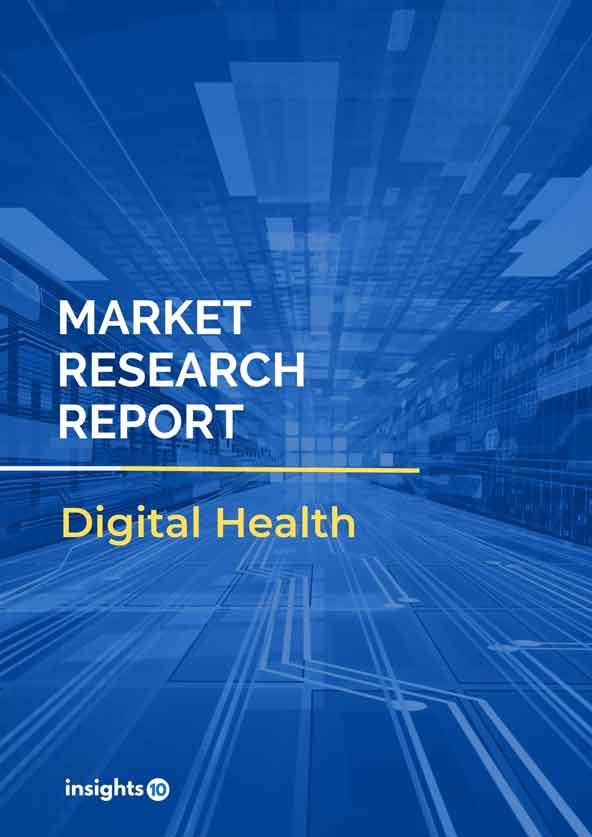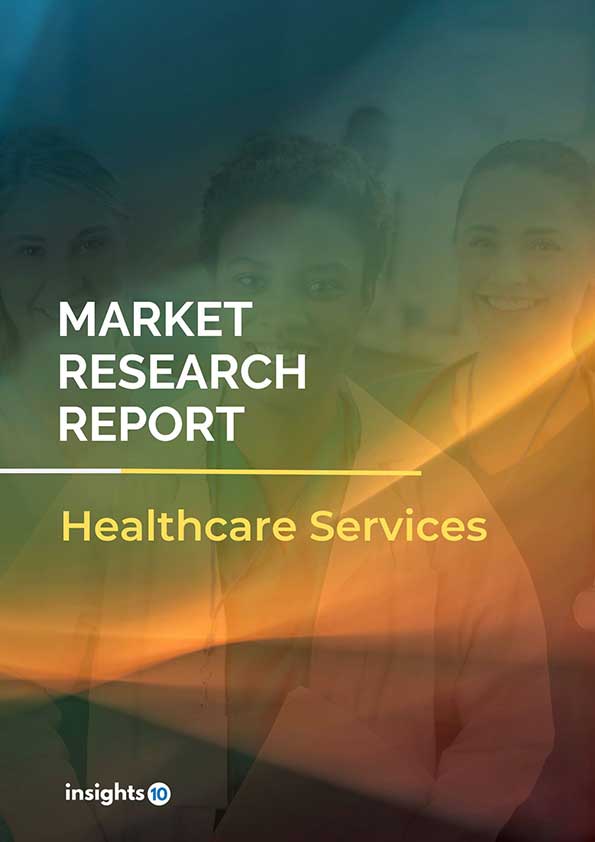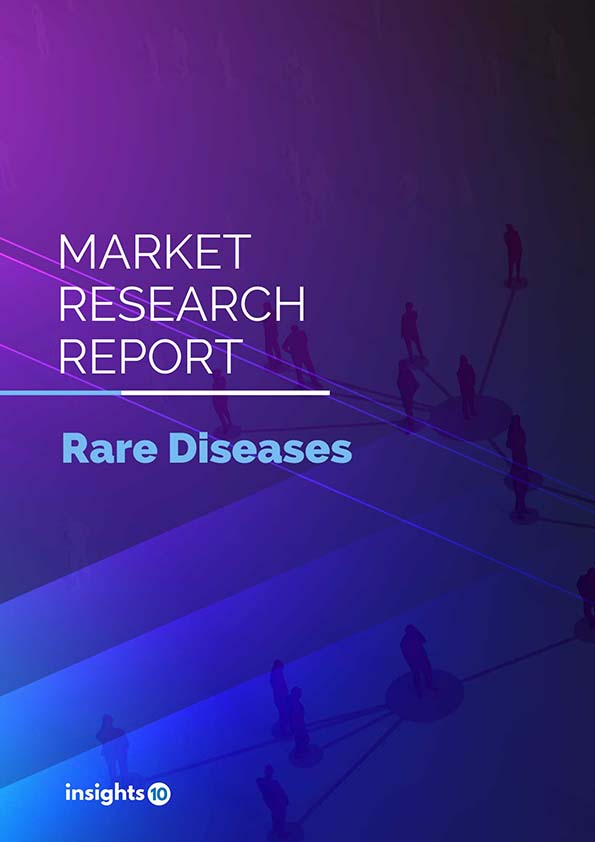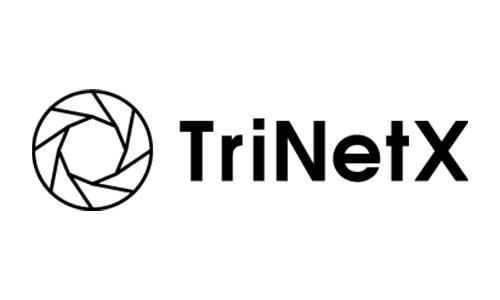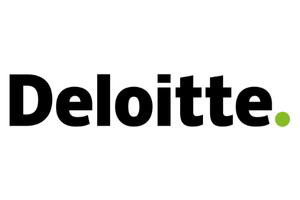India Digital Health Market Analysis
India's digital health market is projected to grow from $3.83 Bn in 2022 to $18.34 Bn by 2030, registering a CAGR of 21.6% during the forecast period of 2022-30. A combination of a large potential market and supportive government policies is expected to drive strong growth in the India digital health market in the coming years. The market is segmented by solution, by deployment, by end-use. Some of the major players include Practo Technologies Pvt. Ltd, Philips Healthcare & Siemens Healthcare Pvt.
Buy Now

India Digital Health Market Executive Summary
India's digital health market is projected to grow from $3.83 Bn in 2022 to $18.34 Bn by 2030, registering a CAGR of 21.6% during the forecast period of 2022-30. According to World Health Organization (WHO) Global Health Expenditure database, health expenditure (% of GDP) of India has grown from 2.95% in 2018 to 3.01% in 2019. The majority of healthcare costs in India is borne by individuals rather than the government or insurance companies. According to the National Health Accounts, the figure has improved over time, falling to 48.21 % in 2018-2019 from 69.4 % in 2004-2005. Though it has declined over time, it remains higher than the global average of 18.1%. Attempts have been made to boost government expenditure on healthcare and extend health insurance coverage.
Digital healthcare entails the use of digital tools and communication platforms to offer healthcare services and information remotely. Video consultations with physicians, remote monitoring of patient's health status, and the use of mobile applications to track symptoms and manage chronic diseases are examples of this. They have been widely impactful in providing convenience and accessibility to patients and potentially lowering healthcare costs. The digital health market in India is quickly expanding, with the potential to enhance healthcare access and boost healthcare system efficiency. Telemedicine, Electronic Health Records (EHRs) & medical devices are some areas where digital health is growing in India. To secure Indian citizens' digital health data, the Government of India adopted the draught Digital Information Security in Healthcare Act 2018 (the "DISHA Bill"). The DISHA Bill defines "digital health data" as an electronic record of an individual's health-related information and aims to standardize and regulate the procedures associated with the collecting, storage, transmission, and use of digital health data, as well as to assure the dependability, data privacy, confidentiality, and security of such data.
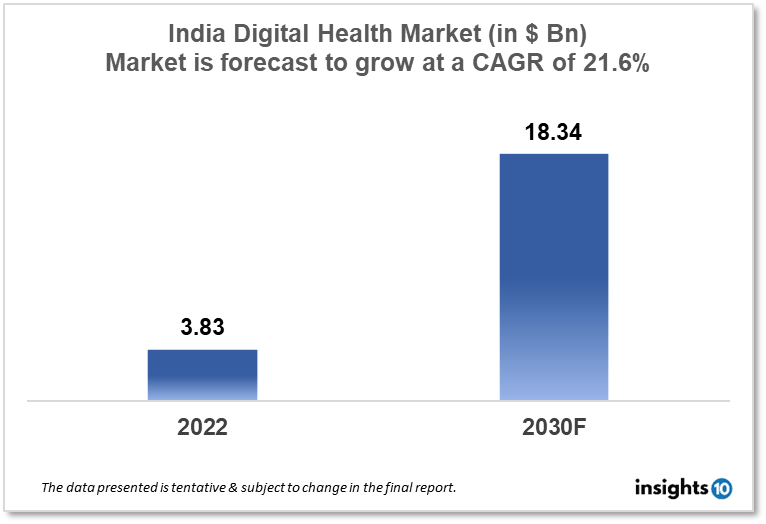
Market Dynamics
Market Growth Drivers
In 2020, The Government of India started the National Digital Health Mission (NDHM) 2020 to accomplish the aim of universal health coverage and to make government services more widely available online. This along with other factors such as an increase in demand for healthcare services due to COVID – 19 pandemic and a shortage of healthcare professionals due to the massive population led to more reliability on digital channels as opposed to physical visits. Increasing the adoption of smartphones and internet access to digital healthcare services can provide a more cost-effective alternative for India. Continuous technological innovation and investment by the private sector will encourage market expansion in the future.
Market Restraints
Many people in India lack the digital literacy skills necessary to effectively digitalize healthcare services, limiting their use and expansion. A lack of trained professionals leads to a lack of standardization and regulation for digital healthcare services in India, which can make it difficult for patients to trust and use these services. Internet and smartphone penetration in India is low, particularly in rural regions, making it challenging for digital healthcare services to reach a big segment of the population.
Moreover, digital healthcare in India is further hampered by a lack of digital infrastructure and data safety concerns, which may restrict sensitive data from being utilized for marketing gain. Many physicians and patients in India are unfamiliar with the notion of digital healthcare and may be hesitant to modify their current methods and practices.
Competitive Landscape
Key Players
- DocEngage Informatics (IND)
- Gems3s Technologies Pvt. Ltd. (IND)
- Lybrate India Pvt. Ltd. (IND)
- Practo Technologies Pvt. Ltd (IND)
- Philips Healthcare (NLD)
- Siemens Healthcare Pvt (IND)
Notable Recent Deals
December 2022: Tata Digital Limited, a 100% subsidiary of Tata Sons Private Limited, to acquire a majority stake in 1mg.
March 2022: Wipro GE Healthcare invested ₹100 crores in the new manufacturing facility.
2018, Siemens Healthineers announced a collaboration with the Indian government to establish a Center of Excellence for Artificial Intelligence (AI) in Healthcare in India.
Healthcare Policies and Regulatory Landscape
Telemedicine practice guidelines by the Medical Council of India in partnership with NITI Aayog, have provided the framework for the regulation of telemedicine practice in India and help to ensure the quality and safety of telemedicine services.
Various government entities, including the Ministry of Health and Family Welfare (MHFW), the Central Drugs Standard Control Organization (CDSCO), and the National Medical Commission (NMC), execute policies that regulate the healthcare sector.
“Ayushman Bharat” is a government-funded health insurance scheme that aims to provide health coverage to over 100 million families in India.
Reimbursement Scenario
In India, the digital healthcare reimbursement landscape is continually expanding and evolving. There is presently no defined reimbursement scheme for digital healthcare services. Some private insurance firms, however, do cover telemedicine consultations, and the government's Ayushman Bharat plan does as well.
The government of India proposed the establishment of a National Digital Health Authority (NDHA) in 2019, which would be in charge of developing a national digital health ecosystem, including the construction of a national health ID, e-pharmacy, and e-diagnostics. However, the reimbursement scenario for digital healthcare services in India remains unclear, therefore policies and regulations are expected to be established and consistent in the near future.
1. Executive Summary
1.1 Digital Health Overview
1.2 Global Scenario
1.3 Country Overview
1.4 Healthcare Scenario in Country
1.5 Digital Health Policy in Country
1.6 Recent Developments in the Country
2. Market Size and Forecasting
2.1 Market Size (With Excel and Methodology)
2.2 Market Segmentation (Check all Segments in Segmentation Section)
3. Market Dynamics
3.1 Market Drivers
3.2 Market Restraints
4. Competitive Landscape
4.1 Major Market Share
4.2 Key Company Profile (Check all Companies in the Summary Section)
4.2.1 Company
4.2.1.1 Overview
4.2.1.2 Product Applications and Services
4.2.1.3 Recent Developments
4.2.1.4 Partnerships Ecosystem
4.2.1.5 Financials (Based on Availability)
5. Reimbursement Scenario
5.1 Reimbursement Regulation
5.2 Reimbursement Process for Diagnosis
5.3 Reimbursement Process for Treatment
6. Methodology and Scope
India Digital Health Market Segmentation
The Digital Health Market is segmented as mentioned below:
By Solution (Revenue, USD Billion):
- Software
- Services
By Deployment (Revenue, USD Billion):
- Cloud-based
- On-premises
By End-use (Revenue, USD Billion):
- Diagnostic Centres
- Healthcare Payers
- Healthcare Research Centres
- Hospitals & Clinics
- Nursing Care Centres
- Others
Methodology for Database Creation
Our database offers a comprehensive list of healthcare centers, meticulously curated to provide detailed information on a wide range of specialties and services. It includes top-tier hospitals, clinics, and diagnostic facilities across 30 countries and 24 specialties, ensuring users can find the healthcare services they need.
Additionally, we provide a comprehensive list of Key Opinion Leaders (KOLs) based on your requirements. Our curated list captures various crucial aspects of the KOLs, offering more than just general information. Whether you're looking to boost brand awareness, drive engagement, or launch a new product, our extensive list of KOLs ensures you have the right experts by your side. Covering 30 countries and 36 specialties, our database guarantees access to the best KOLs in the healthcare industry, supporting strategic decisions and enhancing your initiatives.
How Do We Get It?
Our database is created and maintained through a combination of secondary and primary research methodologies.
1. Secondary Research
With many years of experience in the healthcare field, we have our own rich proprietary data from various past projects. This historical data serves as the foundation for our database. Our continuous process of gathering data involves:
- Analyzing historical proprietary data collected from multiple projects.
- Regularly updating our existing data sets with new findings and trends.
- Ensuring data consistency and accuracy through rigorous validation processes.
With extensive experience in the field, we have developed a proprietary GenAI-based technology that is uniquely tailored to our organization. This advanced technology enables us to scan a wide array of relevant information sources across the internet. Our data-gathering process includes:
- Searching through academic conferences, published research, citations, and social media platforms
- Collecting and compiling diverse data to build a comprehensive and detailed database
- Continuously updating our database with new information to ensure its relevance and accuracy
2. Primary Research
To complement and validate our secondary data, we engage in primary research through local tie-ups and partnerships. This process involves:
- Collaborating with local healthcare providers, hospitals, and clinics to gather real-time data.
- Conducting surveys, interviews, and field studies to collect fresh data directly from the source.
- Continuously refreshing our database to ensure that the information remains current and reliable.
- Validating secondary data through cross-referencing with primary data to ensure accuracy and relevance.
Combining Secondary and Primary Research
By integrating both secondary and primary research methodologies, we ensure that our database is comprehensive, accurate, and up-to-date. The combined process involves:
- Merging historical data from secondary research with real-time data from primary research.
- Conducting thorough data validation and cleansing to remove inconsistencies and errors.
- Organizing data into a structured format that is easily accessible and usable for various applications.
- Continuously monitoring and updating the database to reflect the latest developments and trends in the healthcare field.
Through this meticulous process, we create a final database tailored to each region and domain within the healthcare industry. This approach ensures that our clients receive reliable and relevant data, empowering them to make informed decisions and drive innovation in their respective fields.
To request a free sample copy of this report, please complete the form below.
We value your inquiry and offer free customization with every report to fulfil your exact research needs.
